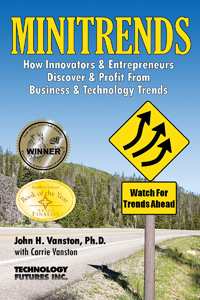Put Aggregators to Work for Quality, Timely Info When Trend Searching
November 29, 2012
Part One of a Two-Part Series by Guest Blogger Steve Pearson, Visionex Solutions, LLC

Photo credit: www.mapthis.net: http://mapthis.net/wp-content/uploads/2010/11/searching-for-info.jpg
I was truly inspired by the recent MiniTrends 2012 Conference and collected many ideas for improving my business and for passing along to my clients.
After reading the MINITRENDS book, I’d like to share some additional technical and patent resources that might help others as much as they help me in my business providing research for product development and innovation.
Google is popular, but not a good source for piecing together trends: access to a large amount of content dumped in your lap through a single portal is not efficient.
Fortunately, there are information resources that provide broad data in a bibliographic form that facilitates finding the information you desire. There are three general groups of these resources:
- business/market
- engineering/science
- patents/patent applications
Of course, many of these specialty resources require fees, but they can be invaluable for businesses and researchers needing timely and accurate information.
Some options:
Business news typically consists of new product announcements, merger and acquisition news and management changes. Many executives find it valuable to monitor their key competitors or the top executives in those companies. There’s a wide breadth of providers in this category and some are free. A good place to start is doing a Google search, probably for a specific company’s name, and then filtering the results by clicking on “news” in the grey colored font immediately below the search box. (More on automated news alerts in Part 2 next week.)
Technical resources provide focused information related to newly published research, dissertations and conference proceedings. Consider Inspec which monitors roughly 5,000 scientific and technical journals plus some conferences and dissertations. These originate from around the world but often have an English abstract.
Technical services can be a pricey, but consider the savings the first time you rethink your current or upcoming R&D efforts based on information that your competitor may not know.
Patents and patent application aggregators collect updates from international patent offices and store this bibliographic information in their databases. Many countries make this information available to the public, but the ease of use varies dramatically.
For instance, the USPTO maintains its own search engine for finding relevant intellectual property, but there are several limitations:
- The information is focused solely on the U.S.
- Searching granted patents and patent applications is done through separate search windows
- The results shown to your inquiry will often require a lot of time to review.
- PDF file export is not available.
A better choice for many is Google Patents as it also covers Europe, is fairly simple to use, provides results that are easier to navigate and allows you to export PDFs.
So, why not use Google Patents for all of your work? There are drawbacks as well:
- It doesn’t cover the remainder of the world
- It’s difficult to drill down to the specific patents and applications that are most relevant to your need
- It’s difficult to do trend analysis
Many companies find that the best way to control their time and expense is to hire an intermediary to decipher these resources and conduct research as needs arise.
Next week: Where to Start with Automated Alerts
Guest blogger Steve Pearson is a consultant helping companies accelerate innovation and product development. Through his firm Visionex Solutions, LLC, he delivers competitor-busting research with tools and reports he has developed over his career as an engineer, trainer and analyst.
Steve specializes in intellectual property management, technology identification and market assessment and takes pride in applying lessons from his broad background to help those in the electrical, mechanical, energy, construction or transportation industries. Visit his site for more information.
Happy Thanksgiving – Thanks for Family Still at Top of Trends
November 21, 2012
The Bitten Word, 2012 Thanksgiving Trends Word Bubble: What’s In and What’s Out at the Thanksgiving Table This Year, http://www.thebittenword.com/thebittenword/2012/11/2012-thanksgiving-trends-.html
Since George Washington gave his Thanksgiving Proclamation in 1789, many things have not changed. According to Mrs. Cubbison’s survey Thanksgiving across America, when asked “to whom or what will you be giving thanks for this year” the majority of Americans once again will be giving thanks for “family,” followed by “health,” “God,” and “friends.” We are glad to hear that!
To see what has changed in eating habits, The Bitten Word has an interesting way of looking at Thanksgiving Trends–word bubbles! They surveyed 11 major food magazines and found what’s in and out this Thanksgiving. Leading their list was that recipes for grilling the turkey seems to be “in.” Personally, we are buying our turkey from Luby’s. With our seemingly increasingly busy lives, I believe this is a trend that is going to continue, at least in my family!
According to Bitten, sweet potatoes are back in for this Thanksgiving’s trends! Glad to hear it. I always love sweet potatoes with marshmallows on top.
Veggies are not so popular this year says Bitten. That’s a trend I’m not following. Green bean casserole is my family’s favorite. Our recipe is 3 cans of regular green beans, Campbells mushroom soup (not too much or they’ll be mushy), and French fried onions on top (usually above the green beans in grocery store). You can throw in mushrooms, almonds, scallions, and/or water chestnuts, too. Mix them all together and put them into the microwave for 5 minutes or so or bake them. Yum!!
Dessert, on the other hand, is still all about pies! Well, I’m certainly thankful for that!
Happy Thanksgiving to all!
Carrie and Your friends at Technology Futures, Inc.
MiniTrends 2012 Conference – Thanks for Making it a Success!
November 15, 2012
 Thank you to all who supported and attended MiniTrends 2012: A Conference on Translating Emerging Trends into Business Opportunities on October 17-18 in Austin, Texas! We enjoyed interacting with everyone and appreciated the contagious enthusiasm. The speakers were fantastic, the synergy between attendees exciting, and the overall response great. Now let’s build on it!
Thank you to all who supported and attended MiniTrends 2012: A Conference on Translating Emerging Trends into Business Opportunities on October 17-18 in Austin, Texas! We enjoyed interacting with everyone and appreciated the contagious enthusiasm. The speakers were fantastic, the synergy between attendees exciting, and the overall response great. Now let’s build on it!
We want to give special thanks to all of our outstanding speakers. A special shout-out goes to our Keynotes John Vanston, David Pearce Snyder, and Bryan Reese whose excellent presentations provided the structure of the conference. Please spread the word on their speaking talents and availability.
 Let’s use the new LinkedIn MiniTrends Group to continue to network and keep the energy going until MiniTrends 2013. Please feel free to share thoughts from the conference and your own minitrends, experiences, and resources. (We may plan a MiniTrends networking and/or educational event or two before the next conference to keep the momentum going.)
Let’s use the new LinkedIn MiniTrends Group to continue to network and keep the energy going until MiniTrends 2013. Please feel free to share thoughts from the conference and your own minitrends, experiences, and resources. (We may plan a MiniTrends networking and/or educational event or two before the next conference to keep the momentum going.)
We also welcome you to “like” us on our Facebook Page. We will be posting pictures of the conference, luncheon, and reception soon.
Please let us know of any progress you make with minitrends that you might uncover and take advantage of, particularly those using concepts from MiniTrends 2012 and the MINITRENDS book. Feel free to send us your ideas and progress or participate in our social media avenues. We are always looking for good examples, and if we use your minitrend, we’ll be sure to give you credit!
Again, thank you for all those who attended and supported MiniTrends 2012. We are looking forward to staying in touch with you until MiniTrends 2013 and welcoming some newcomers, too!


